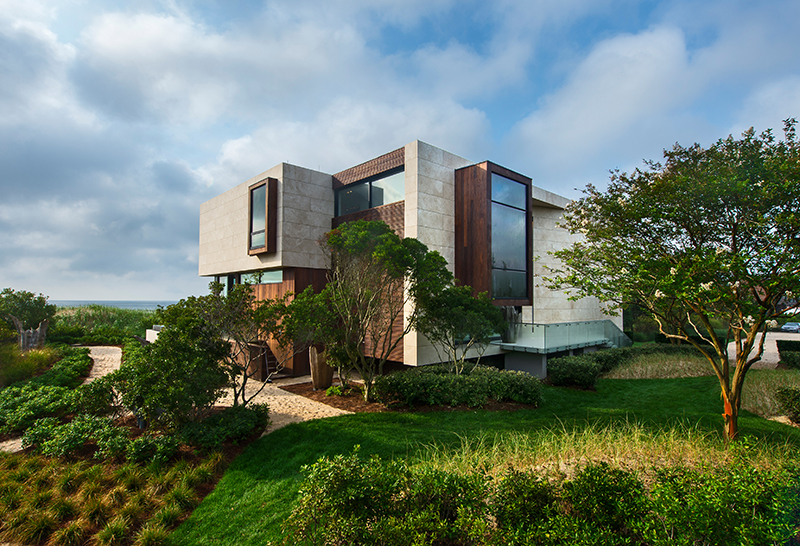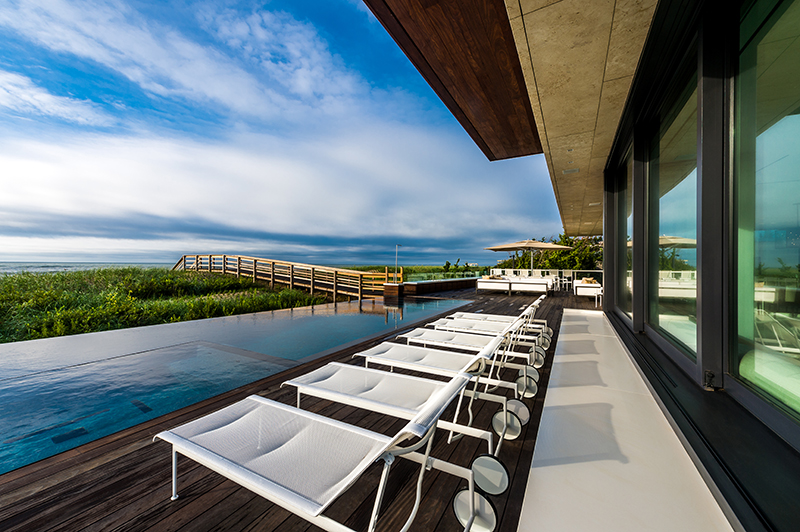Award-winning architect Blaze Makoid has given the classic Hamptons beach house a bold and contemporary new look.
To Blaze Makoid, an architect based in Bridgehampton, NY, designing a statement home for clients is not a matter of how they live. “It’s how they want to live,” he says. Makoid takes the principle of Know Your Client further than most, placing his clients – and their lifestyle aspirations – at the very heart of his design philosophy. He talks of a process of “osmosis” by which he understands his client’s likes, dislikes, habits and inspirations.
“Our goal with each and every project is to create a total built environment that is a modern reflection of our clients while striving for a timeless product that remains fresh, exciting and inspiring,” he says. “We recognize that the investment and trust they place in us is substantial.”
Daniel’s Lane, a sleek, angular four-bedroom home in the Hamptons village of Sagaponack, on the eastern shore of Long Island, is an exemplar of that dedication to client-focused design. The client, a father of three and a successful financier, had just one stipulation for the design: he wanted a house that wasn’t “busy.” Makoid set about creating something that would maximize the narrow, one-acre oceanfront lot and that would appear “simple and clean upon arrival.”
The home Makoid created took inspiration from the Perlbinder house in Sagaponack, the work of iconic architect Norman Jaffe, who, as the designer of choice to Hamptons “royalty”, is credited with bringing rustic Modernism to this part of Long Island. Jaffe regarded the Perlbinder house as one of his early masterpieces. Makoid also took inspiration from Tod Willliams’ house for William Tarlo, also in Sagaponack.
The resulting 5,200-square-foot, two-story home is contemporary and striking with a deliberate simplicity to the clean lines and utilitarian box-like structure. The client had requested a design that was devoid of anything extraneous. “It was about simple design with elegant detailing and execution,” Makoid says. “A refined project starts with a clear idea.”
The two-story travertine entry fac?ade is punctuated by a single glass opening and an oversized cantilevered stair landing that appears to hover above the ground. A layer of service spaces immediately beyond the entry facade gives way to the horizontal expanse of the open-plan living room, dining area and kitchen that stretch along the ocean side of the house. Fifteen-foot wide, floor-to-ceiling glass sliding panels ensure unobstructed views of the ocean and create easy access to the patio and pool beyond.
Common to all of Makoid’s work, there is a cohesiveness that unites the architecture with its interiors and the site – a blurring of the lines between indoors and out. “Our houses have always tried to connect inside to outside visually, aesthetically and functionally,” he says. “This design parameter is almost a cliche? and I see it discussed on projects that really don’t do this at all. I think our work is very good at this and it sets the tone for the entire project.”
The second floor is imagined as a travertine and glass “drawer” that floats above the glass floor below. Three identical bedrooms run from west to east, setting a rhythm that is punctuated by a master bedroom with a balcony – clad in the same afromosia wood as the stair landing – that projects from the wall plane.
The quiet elegance of the house is accentuated by the materials that include poured-in-place concrete floors, Calcutta marble cladding, and afromosia millwork.
The build, which took 18 months, presented some unique challenges. Sited on a narrow, one-acre oceanfront lot, the design had to maximize every inch of what is an increasingly rare commodity in this part of the Hamptons. Because the house was elevated on stilts, with no concrete foundation, using heavy stone was out of the question. To solve the dilemma, Makoid found a company that laminates thin slices of stone onto an aluminum honeycomb panel that was incredibly light, but stronger than solid stone.
Like the earlier Perlbinder House, the structure was built to withstand some harsh Atlantic weather. The design of Daniel’s Lane was one of the first in the village to be affected by the 2010 revision to FEMA flood elevations, requiring a first floor elevation of some 17 feet above sea level. All construction was required to be located landward of the Coastal Erosion Hazard Line. The location within a high velocity wind zone added to the planning and structural challenges.
|
The oceanfront Daniel’s Lane home in Saganponack is a reflection of both the clients coastal lifestyle and the architects own design aesthetic. |
The amendments, however, proved prescient. Some two months after the client and his family moved into the house, Hurricane Sandy struck. While the dune was wiped out, the house was undamaged by the storm. The cantilevered stair landing, Makoid says, was also “structurally interesting.” He used the stair beam as a lateral brace – an example, he notes, of the benefits of working with a good engineer. “We had very few design meetings for this property,” Makoid recounts. “The client put a lot of trust in what we were doing. Though once construction started, he was very present.”
He declines to comment on what the property might be worth today, conceding only that the client wisely bought land at the bottom of the market following the crash of fall 2008.
Makoid himself is from Philadelphia, but has an undoubted attachment to his adopted home – he has lived in the Hamptons since 2002. Pleased that he works most often with referrals, he acknowledges that he is currently working on 10 to 12 other homes in the area. A lot of those are on the water. Many more clients will likely benefit from Makoid’s very personal touch. blazemakoid-architecture.com
Image Credits: Marc Bryan-Brown.




